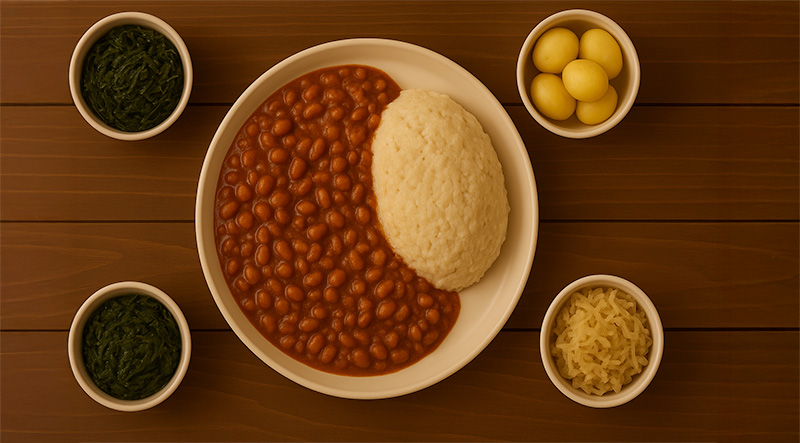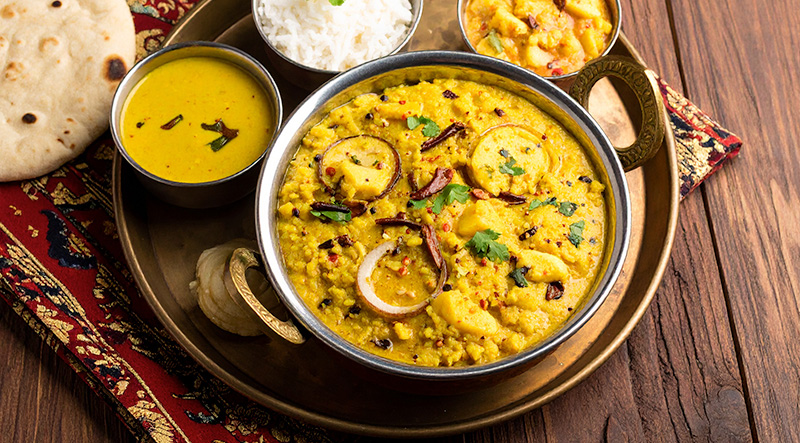Hearty, humble, and deeply satisfying, Sishwala is the national dish of Eswatini that speaks to the soul of Swazi cooking. This thick maize porridge, often served with rich meat stews, beans, or leafy greens, is the ultimate comfort food—simple yet nourishing. Whether scooped by hand or paired with a spoonful of creamy sour milk, Sishwala brings families together around the table in both everyday meals and festive celebrations. With its earthy flavor and wholesome texture, it’s a true taste of tradition that has fed generations with love and pride. Read More...
The History of Sishwala – A National Dish That Rooted in Tradition of Eswatini:
Sishwala, the national dish of Eswatini (formerly Swaziland), is more than just a meal—it is a symbol of cultural identity, community, and resilience. Made from maize meal, Sishwala is a thick, hearty porridge that has fed generations of Swazis and remains central to everyday life and ceremonial gatherings. Its simplicity, affordability, and adaptability have helped it endure across centuries as both a staple and a cultural emblem.
Origins in Agrarian Life:
The roots of Sishwala lie in Eswatini’s agrarian history. For centuries, Swazi communities have relied on subsistence farming, growing maize (corn), sorghum, beans, pumpkins, and other vegetables in rural homesteads. Maize became the dominant crop and quickly became the basis for the most essential food in Swazi diets: porridge. Sishwala, in its thick form, is the heartier version of maize porridge, cooked slowly and stirred continuously to develop its signature dense texture.
Daily Nourishment and Ceremonial Significance:
Sishwala has long been the centerpiece of daily meals in Swazi households. Served with simple stews made from beans, leafy greens, or meat when available, it provides the body with sustained energy and nutrients. But beyond its role as an everyday staple, Sishwala carries cultural and ceremonial weight. At traditional Swazi celebrations—such as weddings, funerals, and royal events—large wooden trays (umcwembe) are filled with Sishwala and surrounded by grilled meats (shisa nyama), relishes, and fermented sour milk (emasi), reinforcing the communal nature of Swazi life.
Evolution of the Dish:
While the basic recipe for Sishwala has remained constant—maize meal, water, and sometimes salt—variations have evolved based on available ingredients and regional preferences. For instance, some families mix boiled sugar beans or ground peanuts into the porridge for added protein and flavor. Others blend in pumpkin to create a sweeter version known as sidvudvu. These additions not only reflect seasonal harvests but also demonstrate the adaptability of the dish to modern nutrition and tastes.
Cultural Identity on a Plate:
For Swazis living abroad, Sishwala remains a powerful connection to home. Its preparation and sharing keep traditions alive and provide a tangible sense of belonging. It is often featured at cultural festivals and diaspora gatherings, where it serves as a bridge between generations, teaching younger Swazis about their heritage through food.
More Than a Meal:
In Eswatini, Sishwala is not just food—it’s a way of life. Its role in strengthening family bonds, supporting local agriculture, and preserving cultural values makes it a cornerstone of the Swazi identity. Whether eaten in a humble village hut or at a royal celebration, Sishwala continues to be a dish that unites people through taste, tradition, and togetherness.

Cook the Beans & Prepare the Stew Base:

Stir and Simmer:

Serve the Dish:
The total preparation and cooking time for traditional Sishwala with bean stew is approximately 1 hour and 30 minutes. This includes about 10–15 minutes of preparation time for chopping onions and tomatoes, soaking beans overnight (if not using canned), and gathering ingredients. The beans require 45–60 minutes to cook until soft, while the stew base and maize porridge each take about 20–30 minutes to prepare and simmer. Both components can be cooked simultaneously to save time, making it a manageable and rewarding meal for both everyday meals and traditional occasions.
A single serving of traditional Sishwala (maize porridge with bean stew), based on the recipe provided, contains approximately 350–450 calories. The majority of the calories come from the maize meal, which provides complex carbohydrates and a small amount of protein. The bean stew contributes additional protein, fiber, and calories—especially when cooked with oil and tomatoes. If optional ingredients like ground peanuts or fermented milk (emasi) are added, the calorie count may increase slightly due to added fats and protein. Overall, Sishwala is a filling, energy-rich meal that’s both nutritious and economical.



